Sarah L. Johnson's Blog, page 115
August 5, 2013
Book review: The White Princess, by Philippa Gregory
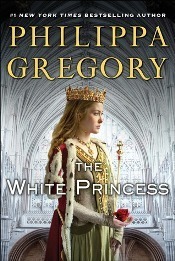 Gregory charts the vicissitudes of a high-stakes political marriage in her latest diverting epic.
Gregory charts the vicissitudes of a high-stakes political marriage in her latest diverting epic.It’s 1485; the Wars of the Roses have ended, but the victorious Henry VII sits insecurely on his throne. Still mourning her lover, Richard III, Princess Elizabeth of York must wed King Henry to unite their warring houses. Unlike his predecessors, Henry has no personal charm, and the novel excels at depicting his paranoia as royal pretenders pop up and threaten England’s stability.
Kept ignorant of the political scheming around her and caught between her York relations and securing her children’s inheritance, Elizabeth can’t match the dynamism of her mother, Elizabeth Woodville (The White Queen, 2009), or mother-in-law, Margaret Beaufort (The Red Queen, 2010), and they occasionally steal the spotlight. Nonetheless, the younger Elizabeth is an observant narrator, and her difficult position reflects historical reality, as does her growing closeness to her beleaguered husband.
The repetitive language will either drive points home for readers or drive them batty, but the novel is as replete with intrigue and heartrending drama as Gregory’s fans expect.
The White Princess was published by Touchstone in hardcover in August ($26.99/Can$29.99, 400pp). Simon & Schuster is the UK publisher (£20.00). This review first appeared in Booklist's July issue.
Some added remarks:
1 - The White Princess is #10 on the NYT bestseller list for hardcover fiction this week.
2 - This is the fifth novel by Philippa Gregory I've reviewed for Booklist; I've covered all of the books in her Cousins' War series except The White Queen, plus The Other Queen as well. My favorites are The Red Queen, about Margaret Beaufort, and The Kingmaker's Daughter, about Anne Neville.
3 - I worry I'm becoming repetitive in describing these novels as repetitive, because this is the 3rd review in which I've said something about it, but while I find the stories entertaining, it's distracting when the narrators say the same phrases over and over... and with this book, this begins with the very first paragraph.
4 - Royalty buffs and those following the series will know that Richard III is the uncle of Elizabeth of York and, yes, they're presented as lovers in this book.
5 - The White Queen miniseries begins in the US this coming Saturday. I'll be watching.
Published on August 05, 2013 05:30
August 2, 2013
Washington Then, Washington Now; Nothing Changes, a guest post by Richard Smolev
My final contributor in this 10-day series of essays from historical novelists is Richard Smolev, whose novel In Praise of Angels: A Novel of the Reconstruction Era was published on Tuesday. Here he discusses some of his primary source research as well as his novel's key themes, which resonate in today's world of political scandals and partisanship. I'm looking forward to reading it and tuning in to an episode from American history that's new to me.
~
Washington Then, Washington Now;Nothing ChangesRichard Smolev
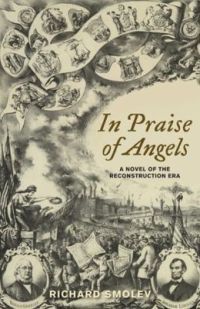 When I began writing my post-Civil War novel In Praise of Angels over 10 years ago, I thought I’d be watching my young protagonist draw strength and a sense of his career from his proximity to both the workings of our government and to the press that he so wanted to admire. But, like so many of us today who are disappointed with both our elected officials’ unwillingness to put aside their political gamesmanship and the rabid partisanship of the media, that does little but stand at each extreme and shout down its opposition, the closer he came to both government and the media the more disappointed he became.
When I began writing my post-Civil War novel In Praise of Angels over 10 years ago, I thought I’d be watching my young protagonist draw strength and a sense of his career from his proximity to both the workings of our government and to the press that he so wanted to admire. But, like so many of us today who are disappointed with both our elected officials’ unwillingness to put aside their political gamesmanship and the rabid partisanship of the media, that does little but stand at each extreme and shout down its opposition, the closer he came to both government and the media the more disappointed he became.
Benjamin Wright lost his two older brothers in one of the first Civil War battles when they were under their father’s command. The trauma of losing his two older sons caused Benjamin’s father to abandon his wife and only remaining son for a job as a Congressional aide. Too young to join the army himself, Benjamin spent the next few years writing eulogies to his brothers and their fallen comrades. When we first meet Benjamin, he is interviewing for a job with a Philadelphia newspaper. Able to land the spot, he is asked to help cover the impeachment trial of Andrew Johnson, on charges brought by the Radical Republicans principally because they disagreed with how Johnson was trying to bring the Confederate states back into the Union. I drew much of the color of that part of the novel from contemporaneous articles in Harper’s Weekly.
The impeachment trial is Benjamin’s first exposure to Washington, but hardly the most significant. Through some digging into court records, he finds a lawsuit in which Henry McComb is suing Oakes Ames, a Massachusetts Congressman, to recover shares in an entity known as the Credit Mobilier.
 Author Richard Smolev and grandchildBenjamin is able to ferret out information suggesting first that the Credit Mobilier was being used as a vehicle to steal millions from the government by overcharging for the construction of the transcontinental railroad and second, that Ames was passing out shares to members of Congress to win their support. The scandal rose to the center of the 1872 Presidential election between Ulysses Grant and Horace Greeley, in which Benjamin played an important role, and led to a Congressional investigation.
Author Richard Smolev and grandchildBenjamin is able to ferret out information suggesting first that the Credit Mobilier was being used as a vehicle to steal millions from the government by overcharging for the construction of the transcontinental railroad and second, that Ames was passing out shares to members of Congress to win their support. The scandal rose to the center of the 1872 Presidential election between Ulysses Grant and Horace Greeley, in which Benjamin played an important role, and led to a Congressional investigation.
I was able to download the House report on the scandal from February 1873, which became the foundation for much of the story. Interestingly, Thomas Nast published a political cartoon in Harper’s Weekly in March 1873, and I was able to get the rights to use the cartoon in the book from the Princeton rare books library.
Of course Benjamin is more than a mere witness to history. As intoxicating as it was for him to be so close to these significant events in our nation’s history, the standing he developed as a newspaper reporter comes at an enormous personal cost that forces Benjamin to ask what direction he wants his life to take.
~
Richard Smolev, a retired attorney, lives and writes in Bucks County, PA. His first novel, Offerings, was published in 2012. In Praise of Angels was published by Academy Chicago on July 30th in hardcover ($35), trade paperback ($19.95) and e-book ($7.99).
~
Washington Then, Washington Now;Nothing ChangesRichard Smolev
 When I began writing my post-Civil War novel In Praise of Angels over 10 years ago, I thought I’d be watching my young protagonist draw strength and a sense of his career from his proximity to both the workings of our government and to the press that he so wanted to admire. But, like so many of us today who are disappointed with both our elected officials’ unwillingness to put aside their political gamesmanship and the rabid partisanship of the media, that does little but stand at each extreme and shout down its opposition, the closer he came to both government and the media the more disappointed he became.
When I began writing my post-Civil War novel In Praise of Angels over 10 years ago, I thought I’d be watching my young protagonist draw strength and a sense of his career from his proximity to both the workings of our government and to the press that he so wanted to admire. But, like so many of us today who are disappointed with both our elected officials’ unwillingness to put aside their political gamesmanship and the rabid partisanship of the media, that does little but stand at each extreme and shout down its opposition, the closer he came to both government and the media the more disappointed he became.Benjamin Wright lost his two older brothers in one of the first Civil War battles when they were under their father’s command. The trauma of losing his two older sons caused Benjamin’s father to abandon his wife and only remaining son for a job as a Congressional aide. Too young to join the army himself, Benjamin spent the next few years writing eulogies to his brothers and their fallen comrades. When we first meet Benjamin, he is interviewing for a job with a Philadelphia newspaper. Able to land the spot, he is asked to help cover the impeachment trial of Andrew Johnson, on charges brought by the Radical Republicans principally because they disagreed with how Johnson was trying to bring the Confederate states back into the Union. I drew much of the color of that part of the novel from contemporaneous articles in Harper’s Weekly.
The impeachment trial is Benjamin’s first exposure to Washington, but hardly the most significant. Through some digging into court records, he finds a lawsuit in which Henry McComb is suing Oakes Ames, a Massachusetts Congressman, to recover shares in an entity known as the Credit Mobilier.
 Author Richard Smolev and grandchildBenjamin is able to ferret out information suggesting first that the Credit Mobilier was being used as a vehicle to steal millions from the government by overcharging for the construction of the transcontinental railroad and second, that Ames was passing out shares to members of Congress to win their support. The scandal rose to the center of the 1872 Presidential election between Ulysses Grant and Horace Greeley, in which Benjamin played an important role, and led to a Congressional investigation.
Author Richard Smolev and grandchildBenjamin is able to ferret out information suggesting first that the Credit Mobilier was being used as a vehicle to steal millions from the government by overcharging for the construction of the transcontinental railroad and second, that Ames was passing out shares to members of Congress to win their support. The scandal rose to the center of the 1872 Presidential election between Ulysses Grant and Horace Greeley, in which Benjamin played an important role, and led to a Congressional investigation.I was able to download the House report on the scandal from February 1873, which became the foundation for much of the story. Interestingly, Thomas Nast published a political cartoon in Harper’s Weekly in March 1873, and I was able to get the rights to use the cartoon in the book from the Princeton rare books library.
Of course Benjamin is more than a mere witness to history. As intoxicating as it was for him to be so close to these significant events in our nation’s history, the standing he developed as a newspaper reporter comes at an enormous personal cost that forces Benjamin to ask what direction he wants his life to take.
~
Richard Smolev, a retired attorney, lives and writes in Bucks County, PA. His first novel, Offerings, was published in 2012. In Praise of Angels was published by Academy Chicago on July 30th in hardcover ($35), trade paperback ($19.95) and e-book ($7.99).
Published on August 02, 2013 18:00
August 1, 2013
The Power of Point of View, a guest post by Victoria Wilcox, author of Inheritance
Victoria Wilcox, author of Inheritance, the outstanding first book in her biographical fiction trilogy about Doc Holliday (see my review from 7/22), has contributed an essay about how she used point of view to show all the facets of her protagonist's character, even ones that don't agree with our own moral values, while retaining our sympathy for him. It takes careful skill on an author's part to do this, and I think both readers and writers will get a lot out of her post. Thanks to Victoria, we also have a giveaway for a copy of Inheritance which is open to readers in the US, Canada, and the UK.
~
The Power of Point of ViewVictoria Wilcox
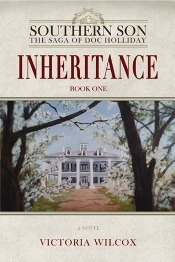 Sarah Johnson's wonderfully written review of Inheritance, the first book in my historical novel trilogy, Southern Son: The Saga of Doc Holliday points out one of the challenges in writing fiction set during the American Civil War and Reconstruction: the difficulty of dealing with the "inherent racism” of the time. Although the Southern Confederacy was fighting for more than slavery in its war on the Federal government, the perpetuation of the “peculiar institution” was at the core of the fight. So a writer telling a story set in the Old South has to acknowledge the central issue of the era, even if that issue isn’t a central theme of the book.
Sarah Johnson's wonderfully written review of Inheritance, the first book in my historical novel trilogy, Southern Son: The Saga of Doc Holliday points out one of the challenges in writing fiction set during the American Civil War and Reconstruction: the difficulty of dealing with the "inherent racism” of the time. Although the Southern Confederacy was fighting for more than slavery in its war on the Federal government, the perpetuation of the “peculiar institution” was at the core of the fight. So a writer telling a story set in the Old South has to acknowledge the central issue of the era, even if that issue isn’t a central theme of the book.
It would be tempting to insert one’s modern perceptions into the narrative, commenting on or criticizing the racist attitudes of the times. Such editorial comment, however, puts a distance between the reader and the characters and detracts from the sense of time and place of the story. How, then, to accurately show the social ills of the Old South without seeming to approve of them? Without some negative commentary the story might seem to celebrate the institution of slavery.
My solution to this literary dilemma was found in telling the entire story of Southern Son in the Third Person Limited point of view, never leaving the mind of John Henry Holliday. The reader sees only what John Henry sees, hears, or learns, which means that there is no escape from witnessing, and being party to, his 19th-century attitudes. He doesn’t consider himself racist (the term may not even have existed in his vocabulary), and he offers no apology for having such thoughts – which the reader then has to share.
Of course this is sometimes uncomfortable – as it is meant to be. The narrator doesn’t need to tell us that John Henry’s attitudes are wrong, and the writer certainly doesn’t need to step in and make the point. The reader will draw those conclusions, being uncomfortable with the things John Henry says and does but unable to get away from those things. The effect is a very personal experience with the mind and heart of a 19th-century man in the last days of the Old South.
Yet in spite of his many flaws, or perhaps because of them, John Henry remains a very sympathetic character. When he does wrong, we want him to do right. When he fails, we want him to succeed. Such personal emotion for an imagined character is the power of the Third Person Limited point of view, putting us solely in the heart of the protagonist and no one else. We care about his life, because his life is all we have.
The second book in the trilogy, Gone West, introduces John Henry to the historical character of Barney Ford, a former runaway slave turned wealthy hotel owner. When Holliday unthinkingly comes to the man’s defense, it’s a telling action that his racial attitudes are changing. By the end of the third book, The Last Decision, Holliday himself comments on the racist attitudes of others, as he finally learns what the reader always knew. And through the Third Person Limited point of view, in the end, we share in his victories.
But Southern Son isn’t about race, any more than John Henry’s life was about racist thinking. It’s a story of heroes and villains, dreams lost and found, families broken and reconciled, of sin and recompense and the redeeming power of love – all seen through the eyes of an American legend.
~
Inheritance was published by Knox Robinson in hardcover in May ($27.99, £19.99, €26.99, 349pp) and as an e-book ($5.99). For more information, see the author's website at http://victoriawilcoxbooks.com.
If you're in the US, Canada, or the UK and would like the chance to win a copy of Inheritance, please fill out the following form. Deadline Friday, August 9th. Good luck!
Loading...
~
The Power of Point of ViewVictoria Wilcox
 Sarah Johnson's wonderfully written review of Inheritance, the first book in my historical novel trilogy, Southern Son: The Saga of Doc Holliday points out one of the challenges in writing fiction set during the American Civil War and Reconstruction: the difficulty of dealing with the "inherent racism” of the time. Although the Southern Confederacy was fighting for more than slavery in its war on the Federal government, the perpetuation of the “peculiar institution” was at the core of the fight. So a writer telling a story set in the Old South has to acknowledge the central issue of the era, even if that issue isn’t a central theme of the book.
Sarah Johnson's wonderfully written review of Inheritance, the first book in my historical novel trilogy, Southern Son: The Saga of Doc Holliday points out one of the challenges in writing fiction set during the American Civil War and Reconstruction: the difficulty of dealing with the "inherent racism” of the time. Although the Southern Confederacy was fighting for more than slavery in its war on the Federal government, the perpetuation of the “peculiar institution” was at the core of the fight. So a writer telling a story set in the Old South has to acknowledge the central issue of the era, even if that issue isn’t a central theme of the book.It would be tempting to insert one’s modern perceptions into the narrative, commenting on or criticizing the racist attitudes of the times. Such editorial comment, however, puts a distance between the reader and the characters and detracts from the sense of time and place of the story. How, then, to accurately show the social ills of the Old South without seeming to approve of them? Without some negative commentary the story might seem to celebrate the institution of slavery.
My solution to this literary dilemma was found in telling the entire story of Southern Son in the Third Person Limited point of view, never leaving the mind of John Henry Holliday. The reader sees only what John Henry sees, hears, or learns, which means that there is no escape from witnessing, and being party to, his 19th-century attitudes. He doesn’t consider himself racist (the term may not even have existed in his vocabulary), and he offers no apology for having such thoughts – which the reader then has to share.
Of course this is sometimes uncomfortable – as it is meant to be. The narrator doesn’t need to tell us that John Henry’s attitudes are wrong, and the writer certainly doesn’t need to step in and make the point. The reader will draw those conclusions, being uncomfortable with the things John Henry says and does but unable to get away from those things. The effect is a very personal experience with the mind and heart of a 19th-century man in the last days of the Old South.
Yet in spite of his many flaws, or perhaps because of them, John Henry remains a very sympathetic character. When he does wrong, we want him to do right. When he fails, we want him to succeed. Such personal emotion for an imagined character is the power of the Third Person Limited point of view, putting us solely in the heart of the protagonist and no one else. We care about his life, because his life is all we have.
The second book in the trilogy, Gone West, introduces John Henry to the historical character of Barney Ford, a former runaway slave turned wealthy hotel owner. When Holliday unthinkingly comes to the man’s defense, it’s a telling action that his racial attitudes are changing. By the end of the third book, The Last Decision, Holliday himself comments on the racist attitudes of others, as he finally learns what the reader always knew. And through the Third Person Limited point of view, in the end, we share in his victories.
But Southern Son isn’t about race, any more than John Henry’s life was about racist thinking. It’s a story of heroes and villains, dreams lost and found, families broken and reconciled, of sin and recompense and the redeeming power of love – all seen through the eyes of an American legend.
~
Inheritance was published by Knox Robinson in hardcover in May ($27.99, £19.99, €26.99, 349pp) and as an e-book ($5.99). For more information, see the author's website at http://victoriawilcoxbooks.com.
If you're in the US, Canada, or the UK and would like the chance to win a copy of Inheritance, please fill out the following form. Deadline Friday, August 9th. Good luck!
Loading...
Published on August 01, 2013 05:30
July 30, 2013
Writing and historical thought: They didn't think like we did 100 years ago, a guest post by Stephanie Carroll
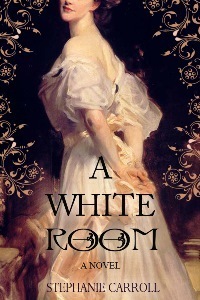 Stephanie Carroll, author of A White Room, is my guest at the blog today. She's here with an essay about a concept that's vitally important for all historical novelists and their readers: the fact that people's ways of thinking have changed over time.
Stephanie Carroll, author of A White Room, is my guest at the blog today. She's here with an essay about a concept that's vitally important for all historical novelists and their readers: the fact that people's ways of thinking have changed over time. A White Room (Unhinged Books, May), set in Missouri in 1900, uses magical realism to evoke the plight of a young wife who feels entrapped by her unsatisfying marriage and suffocatingly close-knit community and who yearns to break free and create a fulfilling life for herself—if she dares. An e-galley arrived in my inbox while I was on a deadline for a review assignment, and I didn't intend to start it right away... but after reading the first few pages, I was completely caught up in the story and carried my Kindle around with me until I read to the end. I enjoyed the small-town Midwestern setting, the twistingly unpredictable plot, the Gothic creepiness of Emeline and John's house, and the message it offered on women's self-empowerment.
Thanks to the author, we have a giveaway at the end, for US readers. Welcome, Stephanie!
~
Writing and Historical Thought:They Didn't Think Like We Did 100 Years Agoby Stephanie Carroll
I recently watched Sherlock Holmes: A Game of Shadows when something struck me. Watson, played by Jude Law, says to Holmes, played by Robert Downey Jr., that he didn’t just want a wife, he wanted “a relationship.”
I paused at that. Wait a second. I don’t think the concept of “a relationship” as we know it today was around in the nineteenth century. Marriages were entered into for monetary reasons, to combine families, elevate rank, and for the need to survive. Further, in the past, people didn’t think of love the way we do now. Life wasn’t all about finding one’s true love. Love was something that grew in a marriage with time, if you were lucky.
“I know you’re scared, but Emma, this is what people do. You get married. You have children.”“You don’t have to.”“Yes, I do.” His face hardened. “If I lived out on my own and didn’t get married, I would starve to death, but not before traipsing around in trousers full of holes.”I held back a giggle. “What?”“I don’t know how to do any of the ‘secret’ stuff you and Mother do. If someone threw me in a kitchen with everything I needed and a set of detailed instructions, I’d cook my own hand.”—A White Room, page 32
Now, occasionally people would wed for affectionate reasons, and this was a growing trend at the time. Still, they didn’t have this concept of “a relationship,” which in Watson’s use clearly is a modern-day reference to a partnership that involves equal give-and-take to maintain a healthy dynamic. That’s a product of late twentieth-century psychology.
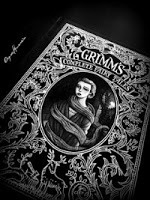 credit aqsahu via photopin ccI’m not dissing Sherlock Holmes. I love those movies, and really those movies are commercial blockbusters, so that level of historical fine-tuning isn’t what the audience wants or expects. I’m just using that as an example of a modern-day concept that hasn’t always been that way.
credit aqsahu via photopin ccI’m not dissing Sherlock Holmes. I love those movies, and really those movies are commercial blockbusters, so that level of historical fine-tuning isn’t what the audience wants or expects. I’m just using that as an example of a modern-day concept that hasn’t always been that way. Finding happiness is another idea that has changed over time. For many historical people, like in the Dark Ages for example, the idea that one strives for happiness in life—ha! Why do you think the original fairy tales often times ended with some gore? Life was hard, physical pain was the norm, a huge percentage of children didn’t live past five years of age, a simple bacterial infection could easily be fatal, and the average lifespan was far shorter.
I didn’t want to tell a poor woman she was pregnant.
I couldn’t imagine the news being anything other than bad, as the woman would either already have too many mouths to feed or be so thin and unhealthy that pregnancy would likely be a death sentence. Death was a risk with pregnancy even with the healthiest of women. Even upper-class women with the finest physicians were at risk of dying during childbirth.
—A White Room, page 261
Freedom, war, government, political correctness, religion, heaven, survival, the meaning of life, birth, sex, contraception, medicine, illness, the universe... and I could go on and on about topics that people thought differently about at different times.
While it’s not a big deal for a Robert Downey Jr. movie, for most historical fiction audiences that kind of accuracy is not only desired but expected. Readers will stop reading if pulled out of the story by something that makes them think: that wouldn’t have happened. Television and movies can get away with it because they keep moving regardless of the audience’s doubt. Books, on the other hand, can lose an audience completely if the reader has a reason to stop.
Historical fiction writers often focus on the tangible facts as opposed to the abstract, so historical thought can be a pitfall. However, it really doesn’t take much of a different approach as far as research goes. It’s just a matter of being aware that thought changes over time and applying the research appropriately.
Sure, we as writers or historians cannot possibly know the exact thoughts of historical people, but we do know enough to create historical characters that will satisfy the reader. Primary sources are extremely useful for this, like diaries and letters where people bare their souls. Newspaper will reveal the current events and discoveries that were on people’s minds. Secondary sources are also useful for learning general beliefs as well as societal and cultural norms.
“What’s that?” Lottie asked.
“It’s to kill germs,” I said.
“What are germs?”
“Germs—they make you sick.”
“Really?”
“Oh, yes,” Oliver said. “I heard ’bout ’em. They on everything, too. People get ’em off of telegraphs and from books and sich.”
“No.” Lottie clasped a hand to her chest, fingers splayed out.
—A White Room, page 188
Further, even though you cannot know the specific thoughts of historical people, you can be confident that there are some modes of thinking all people have regardless of the time period. Judging, self-righteousness, self-consciousness, guilt, embarrassment, generalizations (as in: I never win), exaggeration, and pity are all examples of inner thoughts we all have. It’s just the context that will change throughout history.
I observed her ring finger—bare. My Aunt Cheryl once told me that the only well-off women who weren’t married and worked were ugly, dumb, or otherwise defective. However, Miss McKenzie had a heart-shaped face with bright brown eyes, pronounced cheekbones, and pink lips.
—A White Room, page 203
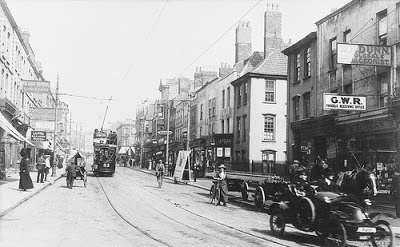 Credit: brizzlebornandbred via photopin cc
Credit: brizzlebornandbred via photopin ccThe most difficult thing about writing historical thought is dealing with the fact that modern-day readers adhere to modern-day thought. Regardless of your accuracy, if your reader doesn’t believe something, it will have the same effect as a mistake. In my original manuscript, I had my main character wondering about what was going to happen on her wedding night. Almost every single reader said it was unbelievable for a woman of her age to know nothing of sex. It didn’t matter that it was a common occurrence that I’d read in Victorian letters – readers didn’t believe it.
Another difficult task is writing historical thought for readers who adhere to modern-day political correctness. This is something that every writer has to figure out for themselves as far as how important it is to his or her story to be accurate or to risk offense.
“It’s all right.” I reached out to touch his hand, giant and moist.
He flinched and pulled back. I knew it was unacceptable for a colored man to touch a white woman …
—A White Room, page 175
And finally, read up on the history of thought.
Yeah, I’m not just making this up – it’s an area of historical study!
And I’ve got the links to Amazon books to prove it!
A Brief History of Thought: A Philosophical Guide to Living by Luc Ferry~
Ideas: A History of Thought and Invention, from Fire to Freud by Peter Watson
A History of Knowledge: Past, Present, and Future by Charles Van Doren
The History of Christian Thought by Jonathan Hill
Freud and Beyond: A History of Modern Psychoanalytic Thought by Stephen A. Mitchell & M. J. Black
A History of Freedom of Thought by J. B. Bury and H. J. Blackham
A History of Western Political Thought by J. S. McClelland and Dr J S Mcclelland
About the Author
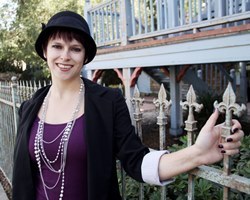 As a reporter and community editor, Stephanie Carroll earned first place awards from the National Newspaper Association and from the Nevada Press Association. Stephanie holds degrees in history and social science. She graduated summa cum laude from California State University, Fresno.
As a reporter and community editor, Stephanie Carroll earned first place awards from the National Newspaper Association and from the Nevada Press Association. Stephanie holds degrees in history and social science. She graduated summa cum laude from California State University, Fresno. Her dark and magical writing is inspired by the classic authors Charlotte Perkins Gilman (The Yellow Wallpaper), Frances Hodgson Burnett (The Secret Garden), and Emily Bronte (Wuthering Heights).
Stephanie writes The Unhinged Historian blog, exploring the dark side of the Victorian Era and Gilded Age, and Unhinged & Empowered Navy Wives for conquering those little moments that make Navy Wives feel crazy. Stephanie lives in California, where her husband is stationed with the U.S. Navy. Her website is www.stephaniecarroll.net.
A White Room is her debut novel.
Find Stephanie Carroll
Facebook - Twitter - Goodreadswww.stephaniecarroll.net
Stephanie Carroll’s Blogs
The Unhinged Historian Unhinged & Empowered Navy Wives
Advance Praise for A White Room
“A novel of grit, independence, and determination ... An intelligent story, well told.”
—Renée Thompson, author of The Plume Hunter and The Bridge at Valentine
“The best historical fiction makes you forget it’s fiction and forget it’s historical. Reminiscent of The Yellow Wallpaper … the thoughtful, intricate story Carroll relates is absolutely mesmerizing.”
—Eileen Walsh, Ph.D. U.S. Women’s History, University of San Diego
About A White Room
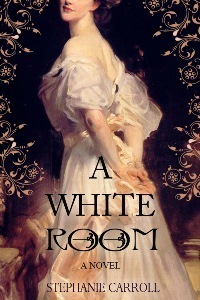 At the close of the Victorian Era, society still expected middle-class women to be “the angels of the house,” even as a select few strived to become something more. In this time of change, Emeline Evans dreamed of becoming a nurse. But when her father dies unexpectedly, Emeline sacrifices her ambitions and rescues her family from destitution by marrying John Dorr, a reserved lawyer who can provide for her family.
At the close of the Victorian Era, society still expected middle-class women to be “the angels of the house,” even as a select few strived to become something more. In this time of change, Emeline Evans dreamed of becoming a nurse. But when her father dies unexpectedly, Emeline sacrifices her ambitions and rescues her family from destitution by marrying John Dorr, a reserved lawyer who can provide for her family.John moves Emeline to the remote Missouri town of Labellum and into an unusual house where her sorrow and uneasiness edge toward madness. Furniture twists and turns before her eyes, people stare out at her from empty rooms, and the house itself conspires against her. The doctor diagnoses hysteria, but the treatment merely reinforces the house’s grip on her mind.
Emeline only finds solace after pursuing an opportunity to serve the poor as an unlicensed nurse. Yet in order to bring comfort to the needy she must secretly defy her husband, whose employer viciously hunts down and prosecutes unlicensed practitioners. Although women are no longer burned at the stake in 1900, disobedience is a symptom of psychological defect, and hysterical women must be controlled.
A novel of madness and secrets, A White Room presents a fantastical glimpse into the forgotten cult of domesticity, where one’s own home could become a prison and a woman has to be willing to risk everything to be free.
Available in Print $14.99 and eBook $3.99 (Kindle, Nook, Sony, e-pub)
Amazon - Barnes & Noble - Sony - Kobo - Inktera - Smashwords - Apple’s iBooks
~
For a chance to win a copy of The White Room (US entries only), please fill out the following form. Deadline Monday, August 5th.
Loading...
Published on July 30, 2013 05:00
July 29, 2013
Jennifer McVeigh's The Fever Tree, about a woman's self-awakening in 1880s South Africa
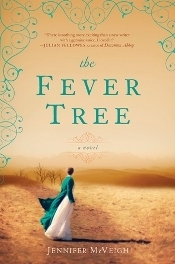 “It’s not an unusual story, really – only the details set it apart,” remarks Dr. Edwin Matthews to our heroine, Frances, describing how he found himself living on the expansive South African plains in 1880. His words could apply equally well to the plot of Jennifer McVeigh’s poignant debut.
“It’s not an unusual story, really – only the details set it apart,” remarks Dr. Edwin Matthews to our heroine, Frances, describing how he found himself living on the expansive South African plains in 1880. His words could apply equally well to the plot of Jennifer McVeigh’s poignant debut. Novels that follow a woman’s path to maturity are hardly groundbreaking, but Frances – well, she’s a complicated person who has more growing up to do than most. Lonely and self-absorbed, she makes so many wretched mistakes that it’s difficult to identify with her even while her plight elicits sympathy.
The Fever Tree places this challenging protagonist in a beautifully rendered setting and follows her transformative journey in expressive language that lets readers judge her and her situation for themselves. It’s these many rich specifics that make the novel stand out.
A Londoner brought up with every privilege, Frances Irvine finds herself penniless and alone following her father’s bad investments and sudden, early death. She has only two choices for her future, both equally undesirable. She can either join her Irish aunt’s household as a nursemaid, or marry Edwin, a distant relation, and establish a new life with him in South Africa, where he works as a physician.
Although Edwin’s aloofness repels her, Frances grudgingly accepts his proposal. However, after meeting charismatic, ambitious William Westbrook on the long voyage to the Cape, she basks in his attentions and plans for her life to take a different course.
Moving between the isolation of a remote cottage on the veldt and the rough-and-tumble diamond mining operation at Kimberley, with its pervasive corruption, greed, and horrific racial inequities, the novel reaches a climax when word spreads about smallpox among the local population – which, if it were true, would have devastating economic impact on the mines and investors.
Frances finds herself caught between Edwin’s noble pursuit of the truth about the epidemic and her continual desire for William. Her growing appreciation for the land around her drives her story on, although she refuses to adapt to her new circumstances and often sees the worst in people who mean her well. Her skewed outlook on her world becomes more obvious as the plot unfolds. Still, her deep character arc makes the denouement all the more powerful.
Scenes in which the red, dusty Karoo region blossoms into life are gloriously envisioned, and the novel amply fulfills its promise of an enticing romantic adventure in an exotic, faraway land. At the same time, it's an eye-opening account about the brutal consequences of imperialism. In many ways it’s reminiscent of W. Somerset Maugham’s A Painted Veil, but with a more hopeful and rewarding ending.
The Fever Tree was published by Putnam/Amy Einhorn in April ($25.95, hb, 432pp). In the UK, the publisher is Penguin (£7.99, pb). Thanks to the publisher for providing me a review copy at my request.
Published on July 29, 2013 06:00
July 27, 2013
Researching the lives of women of the Middle East, a guest post by Janice Weizman - plus giveaway
During my celebration of Small Press Month in March, Janice Weizman's The Wayward Moon was one of the titles I'd highlighted in a showcase of new historical novels from small and independent presses. I'm happy to welcome Janice to Reading the Past today. She has contributed a personal essay detailing how she got the idea to write about a young Jewish woman living through the Golden Age of Islam as well as her research into the historical background. The unique concept and setting of The Wayward Moon interested me so much that I'd bought a copy several months ago, and I'm looking forward to reading it. Thanks to the generosity of the author, we have a giveaway opportunity, too, for US readers.
~
Researching the Lives of Women of the Middle EastJanice Weizman
The year is 854. As the only daughter of a respected physician, Rahel, a young woman living in the Babylonian town of Sura, lives a comfortable and sheltered life, helping her father in his work and dreaming of marriage and a family of her own. On the day she is to meet her fiancé for the first time, Rahel bathes in the town bathhouse, dresses in white, lines her eyes with kohl and colors her lips. Then, as she’s about to perfume herself with rosewater, a crazed assailant bursts into her home and stabs her father. In a wild rush of self defense, Rahel murders the assailant. And then she must flee. With the help of her servant, she disguises herself as a boy and takes to the roads.
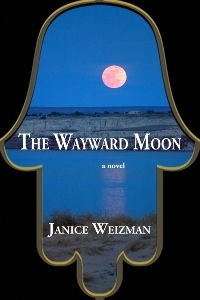 Her adventure will take her to places she’s never imagined: to a life as a kitchen slave in the home of a wealthy Muslim merchant, to a remote Christian monastery, and to a wayside inn for travelers, where she meets a foreign traveler from the far west. As she makes her way through the fascinating and dangerous roads of Mesopotamia, Rahel, who has never lacked for anything, must learn how to survive on her own. So begins The Wayward Moon, my historical novel set in the 9th-century Middle East.
Her adventure will take her to places she’s never imagined: to a life as a kitchen slave in the home of a wealthy Muslim merchant, to a remote Christian monastery, and to a wayside inn for travelers, where she meets a foreign traveler from the far west. As she makes her way through the fascinating and dangerous roads of Mesopotamia, Rahel, who has never lacked for anything, must learn how to survive on her own. So begins The Wayward Moon, my historical novel set in the 9th-century Middle East.
People often ask me how I conceived and researched this story – very appropriate questions in light of the fact that I was born and raised in Toronto and there is very little in my background that prepared me to write it. The answer begins in the best of places – with my own curiosity.
I moved to Israel when I was nineteen, almost thirty years ago. I had always been curious about our Arab neighbors – about their culture, their history, and about the Muslim religion. I loved visiting local archeological sights, many of them within an hour or two of my home. And I enjoyed discovering other aspects of Arab culture – the music, the markets, the literature, the food.
But it was only about 10 years ago, when the phenomenon of suicide bombings emerged, that I felt a need to acquire a deeper understanding about Islam. Following the events of 9/11, I enrolled in a course entitled The History of Islam. It doesn’t often happen that something captures your imagination so fully that you are inspired to create a work of your own, but that is what happened to me.
As we read and discussed the development of Islam – from the tribes of Arabia to the cosmopolitan centers of Damascus and, Baghdad, I discovered a side of Islam that I had not known about. In its Golden Age (750-1250 AD), Islam was one of the world’s most sophisticated cultures, one which valued scholarship, music and poetry, scientific inquiry, and theological debate. I was intrigued to learn that it was in this period that Arab scholars, many of them Christian, translated the classical works of the Greeks, Romans, and others into Arabic, and then went on to engage with and develop new ideas about philosophy, alchemy, medicine, architecture, mathematics, astronomy and optics. The city of Baghdad, with its palaces, markets, hospitals and libraries, was the center of this explosion of learning, commerce and creativity.
As I learned more, I wondered about the lives of women in this society. Except for mothers or desired lovers, they are almost absent from the texts that have come down to us. Uneducated, illiterate, denied all freedom of movement, and forced to consign every aspect of their physical/sexual lives to the will of others, there is nonetheless no doubt that they were there, partaking in the life of their communities from the sidelines.
What would have happened, I wondered, if a woman of this time were suddenly free of all constraint? If she had no father or brothers to protect, or limit her? If she was given the opportunity to study, to use her mind, to develop her abilities? What if she were free to travel where she wished? If she slowly discovered what it means to have autonomy over your sexual experiences and relationships?
 author Janice WeizmanThe word “research” conjures up visions of long days at the library and hours in front of a computer screen. But much of the research I did for The Wayward Moon felt more like an adventure. As the story of Rahel took root in my mind, I had to augment what I had learned about Islam with all I knew of life in the Middle East. I sought out the sites of ancient churches, mosques, monasteries and inns. I recalled tours of old cities in Turkey, Egypt and Morocco, and revisited local markets, landscapes, religious schools and public squares. I read books by women from Arab countries, considering not only their stories, but their values, attitudes, conflicts and joys. I read Arab love poetry, listened to traditional Middle Eastern music, and studied classic works of Persian art. But above all, I listened to the sounds, words and rhythms of the languages of the Middle East, Arabic, Hebrew, Aramaic, Syriac. And as I opened my eyes and my ears, a vision of what the life of my heroine might have been like emerged.
author Janice WeizmanThe word “research” conjures up visions of long days at the library and hours in front of a computer screen. But much of the research I did for The Wayward Moon felt more like an adventure. As the story of Rahel took root in my mind, I had to augment what I had learned about Islam with all I knew of life in the Middle East. I sought out the sites of ancient churches, mosques, monasteries and inns. I recalled tours of old cities in Turkey, Egypt and Morocco, and revisited local markets, landscapes, religious schools and public squares. I read books by women from Arab countries, considering not only their stories, but their values, attitudes, conflicts and joys. I read Arab love poetry, listened to traditional Middle Eastern music, and studied classic works of Persian art. But above all, I listened to the sounds, words and rhythms of the languages of the Middle East, Arabic, Hebrew, Aramaic, Syriac. And as I opened my eyes and my ears, a vision of what the life of my heroine might have been like emerged.
One of the great things about writing and reading historical fiction is that it leads us to consider our own times from a different angle. How does our culture shape the way we see ourselves? Is there really such a thing as choice? How can anyone realize their full potential in a place that refuses to recognize it?
It is my hope that the novel not only provides a great reading experience, but also offers readers a new way of thinking about the opportunities, and limitations, of our own culture.
~
Janice Weizman's The Wayward Moon was published by Yotzeret Publishing in September 2012 ($14.95 trade pb/$9.99 Kindle, 328pp). The novel was recently awarded Gold Medals in the Independent Publisher Book Awards and the Midwest Book Awards. For more information, see the author's website or the novel's pages at Goodreads and Amazon.
For a chance to win a copy of The Wayward Moon (US entries), please fill out the form below. Deadline Monday, August 5th.
~
Researching the Lives of Women of the Middle EastJanice Weizman
The year is 854. As the only daughter of a respected physician, Rahel, a young woman living in the Babylonian town of Sura, lives a comfortable and sheltered life, helping her father in his work and dreaming of marriage and a family of her own. On the day she is to meet her fiancé for the first time, Rahel bathes in the town bathhouse, dresses in white, lines her eyes with kohl and colors her lips. Then, as she’s about to perfume herself with rosewater, a crazed assailant bursts into her home and stabs her father. In a wild rush of self defense, Rahel murders the assailant. And then she must flee. With the help of her servant, she disguises herself as a boy and takes to the roads.
 Her adventure will take her to places she’s never imagined: to a life as a kitchen slave in the home of a wealthy Muslim merchant, to a remote Christian monastery, and to a wayside inn for travelers, where she meets a foreign traveler from the far west. As she makes her way through the fascinating and dangerous roads of Mesopotamia, Rahel, who has never lacked for anything, must learn how to survive on her own. So begins The Wayward Moon, my historical novel set in the 9th-century Middle East.
Her adventure will take her to places she’s never imagined: to a life as a kitchen slave in the home of a wealthy Muslim merchant, to a remote Christian monastery, and to a wayside inn for travelers, where she meets a foreign traveler from the far west. As she makes her way through the fascinating and dangerous roads of Mesopotamia, Rahel, who has never lacked for anything, must learn how to survive on her own. So begins The Wayward Moon, my historical novel set in the 9th-century Middle East. People often ask me how I conceived and researched this story – very appropriate questions in light of the fact that I was born and raised in Toronto and there is very little in my background that prepared me to write it. The answer begins in the best of places – with my own curiosity.
I moved to Israel when I was nineteen, almost thirty years ago. I had always been curious about our Arab neighbors – about their culture, their history, and about the Muslim religion. I loved visiting local archeological sights, many of them within an hour or two of my home. And I enjoyed discovering other aspects of Arab culture – the music, the markets, the literature, the food.
But it was only about 10 years ago, when the phenomenon of suicide bombings emerged, that I felt a need to acquire a deeper understanding about Islam. Following the events of 9/11, I enrolled in a course entitled The History of Islam. It doesn’t often happen that something captures your imagination so fully that you are inspired to create a work of your own, but that is what happened to me.
As we read and discussed the development of Islam – from the tribes of Arabia to the cosmopolitan centers of Damascus and, Baghdad, I discovered a side of Islam that I had not known about. In its Golden Age (750-1250 AD), Islam was one of the world’s most sophisticated cultures, one which valued scholarship, music and poetry, scientific inquiry, and theological debate. I was intrigued to learn that it was in this period that Arab scholars, many of them Christian, translated the classical works of the Greeks, Romans, and others into Arabic, and then went on to engage with and develop new ideas about philosophy, alchemy, medicine, architecture, mathematics, astronomy and optics. The city of Baghdad, with its palaces, markets, hospitals and libraries, was the center of this explosion of learning, commerce and creativity.
As I learned more, I wondered about the lives of women in this society. Except for mothers or desired lovers, they are almost absent from the texts that have come down to us. Uneducated, illiterate, denied all freedom of movement, and forced to consign every aspect of their physical/sexual lives to the will of others, there is nonetheless no doubt that they were there, partaking in the life of their communities from the sidelines.
What would have happened, I wondered, if a woman of this time were suddenly free of all constraint? If she had no father or brothers to protect, or limit her? If she was given the opportunity to study, to use her mind, to develop her abilities? What if she were free to travel where she wished? If she slowly discovered what it means to have autonomy over your sexual experiences and relationships?
 author Janice WeizmanThe word “research” conjures up visions of long days at the library and hours in front of a computer screen. But much of the research I did for The Wayward Moon felt more like an adventure. As the story of Rahel took root in my mind, I had to augment what I had learned about Islam with all I knew of life in the Middle East. I sought out the sites of ancient churches, mosques, monasteries and inns. I recalled tours of old cities in Turkey, Egypt and Morocco, and revisited local markets, landscapes, religious schools and public squares. I read books by women from Arab countries, considering not only their stories, but their values, attitudes, conflicts and joys. I read Arab love poetry, listened to traditional Middle Eastern music, and studied classic works of Persian art. But above all, I listened to the sounds, words and rhythms of the languages of the Middle East, Arabic, Hebrew, Aramaic, Syriac. And as I opened my eyes and my ears, a vision of what the life of my heroine might have been like emerged.
author Janice WeizmanThe word “research” conjures up visions of long days at the library and hours in front of a computer screen. But much of the research I did for The Wayward Moon felt more like an adventure. As the story of Rahel took root in my mind, I had to augment what I had learned about Islam with all I knew of life in the Middle East. I sought out the sites of ancient churches, mosques, monasteries and inns. I recalled tours of old cities in Turkey, Egypt and Morocco, and revisited local markets, landscapes, religious schools and public squares. I read books by women from Arab countries, considering not only their stories, but their values, attitudes, conflicts and joys. I read Arab love poetry, listened to traditional Middle Eastern music, and studied classic works of Persian art. But above all, I listened to the sounds, words and rhythms of the languages of the Middle East, Arabic, Hebrew, Aramaic, Syriac. And as I opened my eyes and my ears, a vision of what the life of my heroine might have been like emerged. One of the great things about writing and reading historical fiction is that it leads us to consider our own times from a different angle. How does our culture shape the way we see ourselves? Is there really such a thing as choice? How can anyone realize their full potential in a place that refuses to recognize it?
It is my hope that the novel not only provides a great reading experience, but also offers readers a new way of thinking about the opportunities, and limitations, of our own culture.
~
Janice Weizman's The Wayward Moon was published by Yotzeret Publishing in September 2012 ($14.95 trade pb/$9.99 Kindle, 328pp). The novel was recently awarded Gold Medals in the Independent Publisher Book Awards and the Midwest Book Awards. For more information, see the author's website or the novel's pages at Goodreads and Amazon.
For a chance to win a copy of The Wayward Moon (US entries), please fill out the form below. Deadline Monday, August 5th.
Published on July 27, 2013 05:00
July 25, 2013
Katherine Webb's A Half Forgotten Song, a haunting mystery set in 1930s and modern Dorset
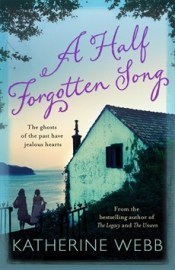 This wasn't a novel that caught me right away. The prose felt languid and almost dreamlike in the beginning, in keeping with the slow-to-change pacing of daily life in the seaside community in Dorset where it's set. After the first hundred pages or so, though, I found myself caught in its web and put it down only with difficulty.
This wasn't a novel that caught me right away. The prose felt languid and almost dreamlike in the beginning, in keeping with the slow-to-change pacing of daily life in the seaside community in Dorset where it's set. After the first hundred pages or so, though, I found myself caught in its web and put it down only with difficulty. A Half Forgotten Song tells two intertwining stories spaced over 70 years apart, and the seamless transitions heighten the sense that the past still exerts a strong hold on the present.
Zach is the owner of a failing art gallery in Bath who's feeling listless after his ex-wife takes their daughter to live in America. When he travels to the village of Blacknowle in Dorset in search of material for a book he's writing on bohemian artist Charles Aubrey, who summered there with his French-Moroccan mistress and two daughters in the '30s, Zach feels he's struck gold after he meets an elderly woman.
Dimity Hatcher was once the subject of many Aubrey portraits, and she informs Zach that she and Charles had had a grand love affair years ago. Dimity doesn't trust many people, but after Zach passes a test she gives him, she decides to tell him some of her story (but not nearly all).
Back in the pre-war years, the girl nicknamed "Mitzy" Hatcher sees a new world open up before her when the Aubreys come to vacation in Blacknowle, attracted by its beauty and quaintness. However, what the Aubreys see as old-fashioned charm is, for Mitzy, depressing poverty. Neglected by her alcoholic mother, who crafts herbal remedies and makes extra money as a prostitute, Mitzy is already an outcast in her community and quickly latches onto the Aubreys – particularly when Charles's artistic gaze falls upon her.
Despondent as Zach is, he doesn't run away from or even question some very odd circumstances he encounters in Blacknowle, such as when Mitzy asks him for some things that would seem like obvious ingredients for a witch's spell. (His potential love interest, Hannah Brock, also lives in absolute squalor; there's a reason behind it, but still.) His lack of reaction requires some suspension of disbelief.
However, this added creepiness sets the right tone for gradual revelations of the darkness in Mitzy's past, and a multi-layered tale about an intense artist, an impressionable young woman, and how a girlhood crush can spiral into an unhealthy, destructive obsession. The revelations at the end are unexpected, astonishing, and definitely worth waiting for.
A Half Forgotten Song was published in May by Harper ($14.99, pb, 496pp). I read it two weekends ago from the UK edition, pictured above, which I'd purchased online last year (Orion, 2012, £7.99).
Published on July 25, 2013 17:30
July 23, 2013
Goddesses, priestesses and princesses: feminine power within Etruscan society, a guest post by Elisabeth Storrs
I'm so pleased to welcome novelist Elisabeth Storrs to Reading the Past. Back in 2010, I reviewed her first novel, The Wedding Shroud, about a young Roman woman in the 5th century BC who marries an Etruscan nobleman to seal an alliance between their warring cities. As part of my review, I had written: "With her page-turning story, Storrs revivifies a long-ago past while reminding us that it’s a place utterly unlike the world we know: the mark of a skilled historical novelist."
Elisabeth's new novel The Golden Dice (Cornelian Press, 2013) continues the story of Caecilia and her husband, Vel Mastarna. It begins seven years after The Wedding Shroud ends so can be read as a sequel, but I'm told it also works well as a standalone novel. I'll be reviewing it here in due course. Today, to whet our appetites for the book, she has contributed an original post about women's power in ancient Etruria. Her essay and accompanying illustrations open a window on a little-known but fascinating culture. Welcome, Elisabeth!
Please read to the end, too, for a chance to win an e-book copy of The Golden Dice (open internationally).
~
Goddesses, Priestesses and Princesses:
Feminine Power within Etruscan Society
Elisabeth Storrs
The Vestal Virgins of Rome are famous. These six priestesses were entrusted with keeping alight the eternal flame of Vesta, the goddess of the hearth. The College of Vestals wielded great influence in matters of state but they were cloistered from society and denied the opportunity to marry and bear children until after they had served the order for thirty years. Apart from the Vestal Virgins, Roman women did not preside over religious ceremonies nor did they hold high office.
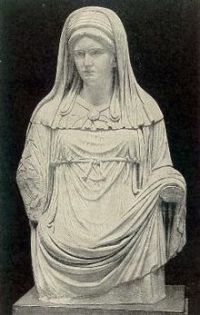 Vestal Virgin
Vestal Virgin
Historians contend that an Etruscan woman could hold the title of a high priestess called an hatrencu. It is believed such priestesses belonged to a sacred college devoted to a female cult dedicated to the fertility of families and marriage. Unlike the Vestals, however, they joined such an order as matrons rather than maidens sworn to an oath of chastity. Interestingly, there is even one tomb where hatrencus have been buried together in one chamber rather than with their families.
The attire of a Vestal Virgin was unique. She wore distinctive robes, woollen headbands and a veil, and her hair was specially dressed in six braids. Votive statuettes have been found of Etruscan women wearing a peculiar garb believed to characterise those of a priestess as well. This consisted of a sleeved tunic reaching to her ankle boots. A heavy mantle with a tasselled triangular end hung over her back. Often her shawl-like cloak was pinned at the shoulder with a large brooch similar to those worn by male Etruscan soothsayers, and her hair was covered by a clinging veil placed low across the forehead and tied by a ribbon knotted at the back of her head.
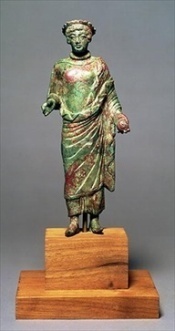 Etruscan priestess
Etruscan priestess
In 1861 the German historian Bachofen propounded a theory that Etruscan society was a matriarchy where identity passed through the female line. His theories were extensively discussed in feminist circles in the 1970s with research undertaken into the cult of the great mother goddess. Indeed, the first deities to be mentioned in Etruscan inscriptions are Turan, the goddess of love and fertility, (better known as Venus or Aphrodite) together with Aritimi (Artemis) who was associated in Etruria with the Mistress of Animals, a goddess also worshipped in the Near East.
In support of his claim, Bachofen examined the legend of Tanaquil, a talented prophetess who became the queen of the first Etruscan king of Rome. She exercised tremendous influence and gave real meaning to the saying: ‘the power behind the throne.’ There was also support for his theory due to the existence of many lavish tombs dedicated to women with inscriptions acknowledging both male and female bloodlines. Compare this to a Roman woman who only bore her father’s name in feminine form, and who was not generally commemorated after death.
Present-day historians have discounted Bachofen’s theory because there are no inscriptions denoting Etruscan women as a monarch or chief magistrate. Nor is a man ever described as the ‘husband of’ a woman which would suggest the wife held a dominant role. However there was no separation between church and state in Etruscan society. Those who governed also fulfilled a religious role as a priest. Given this, the fact Etruscan women could be priestesses establishes the eminent role they played in that world. Accordingly, there may well be seeds of truth in the legend of Queen Tanaquil who was honoured as both a seer and an advisor to her royal husband. Indeed, the extensive treasure found in graves of Etruscan women points to the conclusion that the wives and daughters of the prominent elite were viewed as ‘princesses’.
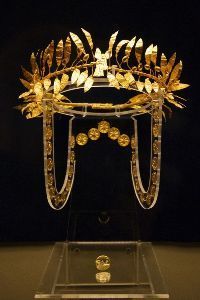 Etruscan gold diadem
Etruscan gold diadem
One particular sarcophagus confirms the high rank held by women in Etruria. On its lid, an aged man and woman lie beneath a mantle. Their intimate embrace not only portrays their devotion but also symbolises how the power of their union can ward off evil after death. Although the casket portrays both husband and wife, it only holds the body of the woman. She is simply described as Ramtha Visnai, wife of Arnth Tetnies.
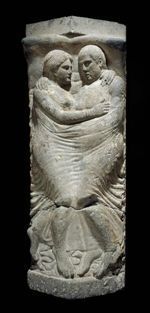 Ramtha Visnai and Arnth Tetnies
Ramtha Visnai and Arnth Tetnies
On one side of the sarcophagus is carved a scene of a procession believed to portray the journey of the couple to the afterlife. Attendants walk behind both husband and wife. Arnth’s carry symbols of his magistracy – a horn, ivory chair and rod; Ramtha’s servants carry libation vessels for mixing wine and water. These symbols are associated with priestesses who served the Etruscan wine god Fufluns (Greek Dionysus). The couple are depicted holding hands. Here is a coffin celebrating the life of a loving wife whose rank was as respected as her husband’s. And the scene also bears witness to Ramtha’s desire to meet her spouse as an equal after death.
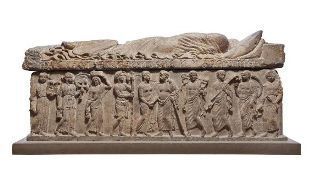 Journey to the afterlife – Ramtha Visnai and Arnth Tetnies
Journey to the afterlife – Ramtha Visnai and Arnth Tetnies
Perhaps the most impressive evidence of the respect afforded to Etruscan women is the fact they were worshipped as part of an ancestor cult. Seated on thrones, statues of both male and female heads of clans stand guard over those who have been entombed. These images give testament to the understanding that the soul of the deceased could turn into a deity who returned to watch over the living. In effect, a high ranked matron of a clan was not only a princess but also a goddess – an ultimate display of feminine power.
 The Tales of Ancient Rome series chronicles the events of a ten-year siege between Rome and the Etruscan city of Veii after the marriage of a young Roman girl, Caecilia, to an Etruscan nobleman, Vel Mastarna. The first book, The Wedding Shroud, ends when war is declared. Newly released, The Golden Dice continues the story seven years later at the height of the conflict. In addition to following the Roman treaty bride, Caecilia (who is now the matriarch of the wealthy House of Mastarna), two other strong female characters are introduced: Semni, a young Etruscan girl, and Pinna, a Roman tomb whore. Past readers of The Wedding Shroud will enjoy visiting Etruria again while others might like to venture into this world for the first time to learn how three women of the ancient world endure a war.
The Tales of Ancient Rome series chronicles the events of a ten-year siege between Rome and the Etruscan city of Veii after the marriage of a young Roman girl, Caecilia, to an Etruscan nobleman, Vel Mastarna. The first book, The Wedding Shroud, ends when war is declared. Newly released, The Golden Dice continues the story seven years later at the height of the conflict. In addition to following the Roman treaty bride, Caecilia (who is now the matriarch of the wealthy House of Mastarna), two other strong female characters are introduced: Semni, a young Etruscan girl, and Pinna, a Roman tomb whore. Past readers of The Wedding Shroud will enjoy visiting Etruria again while others might like to venture into this world for the first time to learn how three women of the ancient world endure a war.
You will find more information on the background to Elisabeth’s books in this post on her blog, Triclinium. The Wedding Shroud and The Golden Dice are available on Amazon or via other retailers listed on her website. And Elisabeth would love to connect with you on Facebook and Twitter.
Description of The Golden Dice:
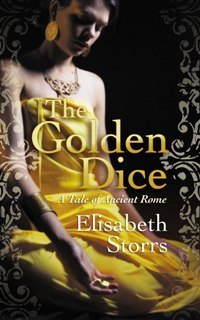 During a ten-year siege between two age-old enemies, three women follow very different paths to survive:
During a ten-year siege between two age-old enemies, three women follow very different paths to survive:
Caecilia, a young Roman woman, forsakes her city by marrying the Etruscan Vel Mastarna, exposing herself to the enmity of his people and the hatred of the Romans who consider her a traitoress…
Semni, a reckless Etruscan girl, becomes a servant in the House of Mastarna, embroiling herself in schemes that threaten Caecilia's children and her own chance for romance…
Pinna, a tomb whore, uses blackmail to escape her grim life and gain the attention of Rome's greatest general, choosing between her love for him and her loyalty to another…
In this second volume in the Tales of Ancient Rome series, the lives of women in war are explored together with the sexuality, religion, and politics of Roman and Etruscan cultures, two great civilizations of ancient history.
Elisabeth Storrs has long held an interest in the history, myths and legends of the ancient world. She is an Australian author and graduated from the University of Sydney in Arts Law, having studied Classics. She lives with her husband and two sons in Sydney and over the years has worked as a solicitor, corporate lawyer, governance consultant and business writer. The Wedding Shroud was judged runner-up in the international 2012 Sharp Writ Book Awards for general fiction.
~
Giveaway Contest
Thanks to the author, we have a giveaway opportunity. One e-book copy of The Golden Dice (mobi, epub, or pdf) will be sent to a randomly selected blog winner. Please fill out the form below to enter; deadline Monday, August 5th. This contest is open internationally. Good luck!
Loading...
Elisabeth's new novel The Golden Dice (Cornelian Press, 2013) continues the story of Caecilia and her husband, Vel Mastarna. It begins seven years after The Wedding Shroud ends so can be read as a sequel, but I'm told it also works well as a standalone novel. I'll be reviewing it here in due course. Today, to whet our appetites for the book, she has contributed an original post about women's power in ancient Etruria. Her essay and accompanying illustrations open a window on a little-known but fascinating culture. Welcome, Elisabeth!
Please read to the end, too, for a chance to win an e-book copy of The Golden Dice (open internationally).
~
Goddesses, Priestesses and Princesses:
Feminine Power within Etruscan Society
Elisabeth Storrs
The Vestal Virgins of Rome are famous. These six priestesses were entrusted with keeping alight the eternal flame of Vesta, the goddess of the hearth. The College of Vestals wielded great influence in matters of state but they were cloistered from society and denied the opportunity to marry and bear children until after they had served the order for thirty years. Apart from the Vestal Virgins, Roman women did not preside over religious ceremonies nor did they hold high office.
 Vestal Virgin
Vestal VirginHistorians contend that an Etruscan woman could hold the title of a high priestess called an hatrencu. It is believed such priestesses belonged to a sacred college devoted to a female cult dedicated to the fertility of families and marriage. Unlike the Vestals, however, they joined such an order as matrons rather than maidens sworn to an oath of chastity. Interestingly, there is even one tomb where hatrencus have been buried together in one chamber rather than with their families.
The attire of a Vestal Virgin was unique. She wore distinctive robes, woollen headbands and a veil, and her hair was specially dressed in six braids. Votive statuettes have been found of Etruscan women wearing a peculiar garb believed to characterise those of a priestess as well. This consisted of a sleeved tunic reaching to her ankle boots. A heavy mantle with a tasselled triangular end hung over her back. Often her shawl-like cloak was pinned at the shoulder with a large brooch similar to those worn by male Etruscan soothsayers, and her hair was covered by a clinging veil placed low across the forehead and tied by a ribbon knotted at the back of her head.
 Etruscan priestess
Etruscan priestessIn 1861 the German historian Bachofen propounded a theory that Etruscan society was a matriarchy where identity passed through the female line. His theories were extensively discussed in feminist circles in the 1970s with research undertaken into the cult of the great mother goddess. Indeed, the first deities to be mentioned in Etruscan inscriptions are Turan, the goddess of love and fertility, (better known as Venus or Aphrodite) together with Aritimi (Artemis) who was associated in Etruria with the Mistress of Animals, a goddess also worshipped in the Near East.
In support of his claim, Bachofen examined the legend of Tanaquil, a talented prophetess who became the queen of the first Etruscan king of Rome. She exercised tremendous influence and gave real meaning to the saying: ‘the power behind the throne.’ There was also support for his theory due to the existence of many lavish tombs dedicated to women with inscriptions acknowledging both male and female bloodlines. Compare this to a Roman woman who only bore her father’s name in feminine form, and who was not generally commemorated after death.
Present-day historians have discounted Bachofen’s theory because there are no inscriptions denoting Etruscan women as a monarch or chief magistrate. Nor is a man ever described as the ‘husband of’ a woman which would suggest the wife held a dominant role. However there was no separation between church and state in Etruscan society. Those who governed also fulfilled a religious role as a priest. Given this, the fact Etruscan women could be priestesses establishes the eminent role they played in that world. Accordingly, there may well be seeds of truth in the legend of Queen Tanaquil who was honoured as both a seer and an advisor to her royal husband. Indeed, the extensive treasure found in graves of Etruscan women points to the conclusion that the wives and daughters of the prominent elite were viewed as ‘princesses’.
 Etruscan gold diadem
Etruscan gold diademOne particular sarcophagus confirms the high rank held by women in Etruria. On its lid, an aged man and woman lie beneath a mantle. Their intimate embrace not only portrays their devotion but also symbolises how the power of their union can ward off evil after death. Although the casket portrays both husband and wife, it only holds the body of the woman. She is simply described as Ramtha Visnai, wife of Arnth Tetnies.
 Ramtha Visnai and Arnth Tetnies
Ramtha Visnai and Arnth Tetnies On one side of the sarcophagus is carved a scene of a procession believed to portray the journey of the couple to the afterlife. Attendants walk behind both husband and wife. Arnth’s carry symbols of his magistracy – a horn, ivory chair and rod; Ramtha’s servants carry libation vessels for mixing wine and water. These symbols are associated with priestesses who served the Etruscan wine god Fufluns (Greek Dionysus). The couple are depicted holding hands. Here is a coffin celebrating the life of a loving wife whose rank was as respected as her husband’s. And the scene also bears witness to Ramtha’s desire to meet her spouse as an equal after death.
 Journey to the afterlife – Ramtha Visnai and Arnth Tetnies
Journey to the afterlife – Ramtha Visnai and Arnth Tetnies Perhaps the most impressive evidence of the respect afforded to Etruscan women is the fact they were worshipped as part of an ancestor cult. Seated on thrones, statues of both male and female heads of clans stand guard over those who have been entombed. These images give testament to the understanding that the soul of the deceased could turn into a deity who returned to watch over the living. In effect, a high ranked matron of a clan was not only a princess but also a goddess – an ultimate display of feminine power.
 The Tales of Ancient Rome series chronicles the events of a ten-year siege between Rome and the Etruscan city of Veii after the marriage of a young Roman girl, Caecilia, to an Etruscan nobleman, Vel Mastarna. The first book, The Wedding Shroud, ends when war is declared. Newly released, The Golden Dice continues the story seven years later at the height of the conflict. In addition to following the Roman treaty bride, Caecilia (who is now the matriarch of the wealthy House of Mastarna), two other strong female characters are introduced: Semni, a young Etruscan girl, and Pinna, a Roman tomb whore. Past readers of The Wedding Shroud will enjoy visiting Etruria again while others might like to venture into this world for the first time to learn how three women of the ancient world endure a war.
The Tales of Ancient Rome series chronicles the events of a ten-year siege between Rome and the Etruscan city of Veii after the marriage of a young Roman girl, Caecilia, to an Etruscan nobleman, Vel Mastarna. The first book, The Wedding Shroud, ends when war is declared. Newly released, The Golden Dice continues the story seven years later at the height of the conflict. In addition to following the Roman treaty bride, Caecilia (who is now the matriarch of the wealthy House of Mastarna), two other strong female characters are introduced: Semni, a young Etruscan girl, and Pinna, a Roman tomb whore. Past readers of The Wedding Shroud will enjoy visiting Etruria again while others might like to venture into this world for the first time to learn how three women of the ancient world endure a war. You will find more information on the background to Elisabeth’s books in this post on her blog, Triclinium. The Wedding Shroud and The Golden Dice are available on Amazon or via other retailers listed on her website. And Elisabeth would love to connect with you on Facebook and Twitter.
Description of The Golden Dice:
 During a ten-year siege between two age-old enemies, three women follow very different paths to survive:
During a ten-year siege between two age-old enemies, three women follow very different paths to survive: Caecilia, a young Roman woman, forsakes her city by marrying the Etruscan Vel Mastarna, exposing herself to the enmity of his people and the hatred of the Romans who consider her a traitoress…
Semni, a reckless Etruscan girl, becomes a servant in the House of Mastarna, embroiling herself in schemes that threaten Caecilia's children and her own chance for romance…
Pinna, a tomb whore, uses blackmail to escape her grim life and gain the attention of Rome's greatest general, choosing between her love for him and her loyalty to another…
In this second volume in the Tales of Ancient Rome series, the lives of women in war are explored together with the sexuality, religion, and politics of Roman and Etruscan cultures, two great civilizations of ancient history.
Elisabeth Storrs has long held an interest in the history, myths and legends of the ancient world. She is an Australian author and graduated from the University of Sydney in Arts Law, having studied Classics. She lives with her husband and two sons in Sydney and over the years has worked as a solicitor, corporate lawyer, governance consultant and business writer. The Wedding Shroud was judged runner-up in the international 2012 Sharp Writ Book Awards for general fiction.
~
Giveaway Contest
Thanks to the author, we have a giveaway opportunity. One e-book copy of The Golden Dice (mobi, epub, or pdf) will be sent to a randomly selected blog winner. Please fill out the form below to enter; deadline Monday, August 5th. This contest is open internationally. Good luck!
Loading...
Published on July 23, 2013 22:00
Contest winners, and upcoming blog events
Thanks to everyone who entered the giveaways for Gillian Bagwell's Venus in Winter and Gary Schanbacher's Crossing Purgatory. The winners have been selected, with the help of the random number generator at random.org:
Venus in Winter will be going out to Jennifer D and international winner Lynn F.
Crossing Purgatory will be going out to Katharine O.
Congratulations to the three winners, and hope you'll enjoy the books!
Over the next week, I'll be featuring more guest posts and giveaways, and here's a preview of what will be coming up:
Victoria Wilcox will be here with a post about Inheritance, her new novel about Doc Holliday's Southern roots (reviewed yesterday)Elisabeth Storrs, author of The Golden Dice, will be speaking about feminine power in Etruscan societyJanice Weizman, author of The Wayward Moon, will talk about researching women's lives in the 9th-century Middle EastStephanie Carroll, author of The White Room, a novel of female repression and self-determination set in small-town Missouri in 1900, will have an essay about historical thought dating from a century ago. I'm looking forward to featuring these posts, which cover a nice range of historical eras and locales. Hope you'll enjoy following along, too!
Venus in Winter will be going out to Jennifer D and international winner Lynn F.
Crossing Purgatory will be going out to Katharine O.
Congratulations to the three winners, and hope you'll enjoy the books!
Over the next week, I'll be featuring more guest posts and giveaways, and here's a preview of what will be coming up:
Victoria Wilcox will be here with a post about Inheritance, her new novel about Doc Holliday's Southern roots (reviewed yesterday)Elisabeth Storrs, author of The Golden Dice, will be speaking about feminine power in Etruscan societyJanice Weizman, author of The Wayward Moon, will talk about researching women's lives in the 9th-century Middle EastStephanie Carroll, author of The White Room, a novel of female repression and self-determination set in small-town Missouri in 1900, will have an essay about historical thought dating from a century ago. I'm looking forward to featuring these posts, which cover a nice range of historical eras and locales. Hope you'll enjoy following along, too!
Published on July 23, 2013 09:10
July 22, 2013
Book review: Victoria Wilcox's Inheritance (Southern Son, The Saga of Doc Holliday, Book One)
Victoria Wilcox’s Inheritance begins a trilogy about Doc Holliday, a figure from Wild West lore whose name has been linked for over 100 years with the Earp brothers and the 1881 gunfight at the O.K. Corral. This first volume reveals his little-known origins as a son of the Old South: a sensitive yet hot-tempered young man whose early life, in the hands of this talented storyteller, proves every bit as fascinating as his legend.
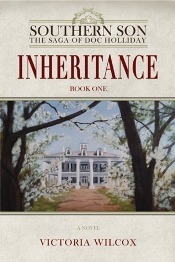 The story opens with a ten-year-old John Henry Holliday attending his grandfather's funeral in 1862 Georgia, taking pride in his “distant Irish ancestors who had fought English invaders” and looking up to his father, a Confederate major who battled Yankee oppression. It concludes in 1873, with John Henry on the run from the law and turning westward towards the future.
The story opens with a ten-year-old John Henry Holliday attending his grandfather's funeral in 1862 Georgia, taking pride in his “distant Irish ancestors who had fought English invaders” and looking up to his father, a Confederate major who battled Yankee oppression. It concludes in 1873, with John Henry on the run from the law and turning westward towards the future.
The tale of his intervening years is full of incident and meticulously detailed – one gets the feeling that very little about his early life has been omitted – but the telling never drags. Dentistry may not sound like the most exciting subject, but Wilcox even makes Holliday's time in dental school sound interesting! The afterword reveals that she based her novel on 18 years of research, and it serves to support and direct the narrative without weighing it down.
Three things shape John Henry into the man he will become: the death from consumption of his beloved mother, who believes in the value of education and from whom he learns his moral lessons; his father’s coldness and too-sudden remarriage to a pretty neighbor; and John Henry’s touching yet hopeless love for his Catholic cousin, Mattie Holliday, a sweet and passionate young woman who was the model for Melanie in Gone with the Wind. (Margaret Mitchell was one of Mattie’s cousins from a different branch, and Mitchell’s fiery Irish-American grandmother, on whom she based the character of Scarlett, makes some memorable appearances, too.)
The importance of family as the center of Southern life is apparent from the first pages, with the genealogical chart and lengthy cast of characters, most of whom are relatives. No need to be wary of this, though, since all of the relationships among "John Henry's people" are clearly presented.
The scenes change along with John Henry’s travels, from his birthplace of Griffin in central Georgia to gas-lit Atlanta streets to the tiny, remote wilderness of Valdosta, and from the bustling sophistication of Philadelphia to the breweries, steamboats, and gambling dens of St. Louis, where he meets an attractive woman who will loom large in his later years.
But even in the big city with all its distractions, when spring arrives he can’t help but long for Georgia, “where the air would be lazy-sweet with a smell of honeysuckle to it, and the azaleas would be blooming pink and white and wild among the pines.”
Both place and time are deftly evoked. John Henry grows up as the only living child of a wealthy Southern family whose fortunes decline after the Civil War and who are forced to reinvent themselves during Reconstruction.The era’s deeply ingrained racism isn't comfortable to read about, and neither are some of John Henry’s attitudes and actions.
Historical novels should provide an honest reflection of their times, and this just one of many things that Inheritance does very well. In all, it accomplishes what it sets out to do – provide an intimate look at the younger Doc Holliday and the Southern roots which formed him – and his story is completely absorbing. For those enamored of Western legends, Gone with the Wind, or American history in general, this grand epic will be a must-read.
~
Inheritance was published by Knox Robinson in hardcover in May ($27.99, £19.99, €26.99, 349pp). For more information, see the author's website at http://victoriawilcoxbooks.com or its reviews on Goodreads, where it has a solid 4.93 rating out of 5.
 The story opens with a ten-year-old John Henry Holliday attending his grandfather's funeral in 1862 Georgia, taking pride in his “distant Irish ancestors who had fought English invaders” and looking up to his father, a Confederate major who battled Yankee oppression. It concludes in 1873, with John Henry on the run from the law and turning westward towards the future.
The story opens with a ten-year-old John Henry Holliday attending his grandfather's funeral in 1862 Georgia, taking pride in his “distant Irish ancestors who had fought English invaders” and looking up to his father, a Confederate major who battled Yankee oppression. It concludes in 1873, with John Henry on the run from the law and turning westward towards the future.The tale of his intervening years is full of incident and meticulously detailed – one gets the feeling that very little about his early life has been omitted – but the telling never drags. Dentistry may not sound like the most exciting subject, but Wilcox even makes Holliday's time in dental school sound interesting! The afterword reveals that she based her novel on 18 years of research, and it serves to support and direct the narrative without weighing it down.
Three things shape John Henry into the man he will become: the death from consumption of his beloved mother, who believes in the value of education and from whom he learns his moral lessons; his father’s coldness and too-sudden remarriage to a pretty neighbor; and John Henry’s touching yet hopeless love for his Catholic cousin, Mattie Holliday, a sweet and passionate young woman who was the model for Melanie in Gone with the Wind. (Margaret Mitchell was one of Mattie’s cousins from a different branch, and Mitchell’s fiery Irish-American grandmother, on whom she based the character of Scarlett, makes some memorable appearances, too.)
The importance of family as the center of Southern life is apparent from the first pages, with the genealogical chart and lengthy cast of characters, most of whom are relatives. No need to be wary of this, though, since all of the relationships among "John Henry's people" are clearly presented.
The scenes change along with John Henry’s travels, from his birthplace of Griffin in central Georgia to gas-lit Atlanta streets to the tiny, remote wilderness of Valdosta, and from the bustling sophistication of Philadelphia to the breweries, steamboats, and gambling dens of St. Louis, where he meets an attractive woman who will loom large in his later years.
But even in the big city with all its distractions, when spring arrives he can’t help but long for Georgia, “where the air would be lazy-sweet with a smell of honeysuckle to it, and the azaleas would be blooming pink and white and wild among the pines.”
Both place and time are deftly evoked. John Henry grows up as the only living child of a wealthy Southern family whose fortunes decline after the Civil War and who are forced to reinvent themselves during Reconstruction.The era’s deeply ingrained racism isn't comfortable to read about, and neither are some of John Henry’s attitudes and actions.
Historical novels should provide an honest reflection of their times, and this just one of many things that Inheritance does very well. In all, it accomplishes what it sets out to do – provide an intimate look at the younger Doc Holliday and the Southern roots which formed him – and his story is completely absorbing. For those enamored of Western legends, Gone with the Wind, or American history in general, this grand epic will be a must-read.
~
Inheritance was published by Knox Robinson in hardcover in May ($27.99, £19.99, €26.99, 349pp). For more information, see the author's website at http://victoriawilcoxbooks.com or its reviews on Goodreads, where it has a solid 4.93 rating out of 5.
Published on July 22, 2013 07:00



